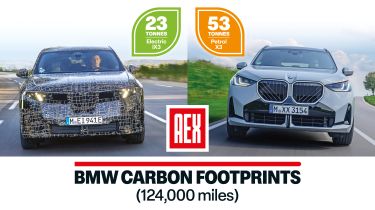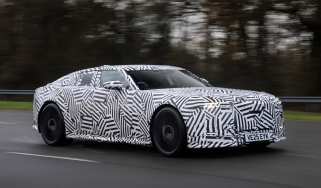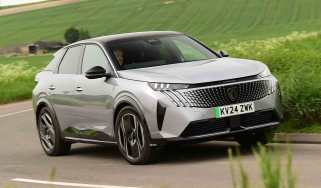How green is an EV? BMW reveals the surprise truth about EV vs ICE carbon footprints
The new BMW iX3 will have less of a carbon footprint than the petrol-powered X3 after just 12,428 miles of driving

Think the fuss over carbon footprints is a load of hot air? Tell that to BMW, which claims to have slashed the environmental impact of producing its all-new iX3 electric SUV by more than one-third.
Despite manufacturing electric cars being more energy intensive than making ICE cars, BMW calculates the iX3 will break even with its X3 petrol equivalent after just 12,428 miles (20,000km) of driving.
That means the average UK driver covering 7,000 miles a year will have paid off an iX3’s embedded carbon debt in less than two years. And they’ll have enjoyed every mile, if their experience lives up to our prototype drive.
The roll-out of BMW’s ‘Neue Klasse’ vehicles, starting with the iX3 that arrives in the UK in March 2026, will trigger the reduced environmental impact. It’s the result of a forensic approach of using renewable energy in its Hungarian car plant and supplier base, and by incorporating more recycled materials in the car, particularly aluminium, steel and thermoplastic.
Can EV batteries be recycled? You bet!
Producing batteries has a significant carbon cost. But it’s a myth that EV batteries aren’t recyclable: half of the lithium, cobalt and nickel in the iX3’s battery is being used for a second time.
Reducing the amount of raw materials needing to be mined, and powering anode and cathode production with green energy, drives down the battery’s CO2 footprint by 42 per cent. All these figures, published for the first time today, have been independently verified – and Polestar is coming clean about how green its cars are too.
Fancy a used BMW iX3? Check out the Auto Express marketplace for great deals on new and used cars
With the Neue Klasse cars, BMW has designed-in carbon-reducing processes on an unprecedented scale. “In every component, we have to ask: can we get secondary raw materials in there? Can we use renewable energies? It’s a total vehicle redesign,” explains Nils Hesse, BMW’s vice president for product sustainability.
Compared: EV and petrol carbon footprints at various mileages
Without this focus, the iX3 50 xDrive’s manufacturing footprint would be 21 tonnes-of-CO2-equivalent (tCO2e) per vehicle. Instead it’s been slashed to 13.5 tCO2e per vehicle – compared with 9.9 tonnes for a petrol X3 20i xDrive coming out of the factory gate.
But the iX3’s 3.6-tonne greater CO2e debt compared with the petrol-powered X3 is paid off after 20,000km, assuming it’s recharged using the typical European Union mix of renewable and carbon energy. Without the Neue Klasse carbon reduction measures, the breakeven point would be at 60,000km (37,284 miles).
Run the iX3 and X3 for 200,000km (124,280 miles), and the petrol SUV will rack up a 52.8-tonne carbon footprint, compared with 14.6 tonnes for the EV recharged strictly on green energy, or 23 tonnes on the EU energy mix. That’s potentially a 38-tonne advantage – for an iX3 powered by the long range, 108kWh battery. The tipping point for smaller battery cars will be lower.
In detail: how has BMW slashed the carbon footprint of new iX3
By weight, around one-third of the new iX3 comes from secondary materials, equivalent to around 740 kilograms.
The wheel carriers and rims are up to four-fifths secondary aluminium, while recycling old fishing nets and ropes contribute 30 per cent of the plastics for the ‘frunk’, the 58-litre storage area in the iX3’s nose.
It’s not just about making sure the right materials go in, but also making them easier to take out at the end of the iX3’s life, to maximise ‘circularity’.
So the Econeer seat’s fleece, glue and the seat textile are all made from the same material, meaning it can all be shredded together when the car is dismantled and sent away for re-use. BMW has also developed a new seat-mounting method and uses fewer components throughout to reduce disassembly time – an important factor to make the secondary-use supply chain economically viable.
“The future goal is to establish a material cycle with the car as a resource, so that we can close the loop at the end,” says Nils Hesse.
The big picture: BMW won’t shy away from sustainability issues
Many companies are now understating their sustainability initiatives, with right-wing political sentiment swinging against environmental action in Europe and the USA. BMW, however, will not be cowed.
“Sustainability is not only important, it’s fundamental,” vows Glenn Schmidt, BMW’s vice president of global sustainability. “Sustainability isn’t just something we say, we are making BMW sustainable.
“We are committed to being net zero by 2050 and we made the commitment in 2020 that we would conform to the Paris accords.”
Schmidt says sustainability is “something that needs to be embedded into all our activities, into our supply chain and also into our product development”. And crucial to that is measurement.
In 2019, BMW calculated its activities generated 150m tonnes of CO2 equivalent. Last year it shrank this to 131 million tCO2e. BMW reckons it’s on track to emit 109 million tCO2e in 2030, and the holy grail – its ‘net zero’ target – is 15 million tonnes per year in 2050.
Click here for our list of the electric cars with the longest range...
Great electric BMW leasing deals
Find a car with the experts




